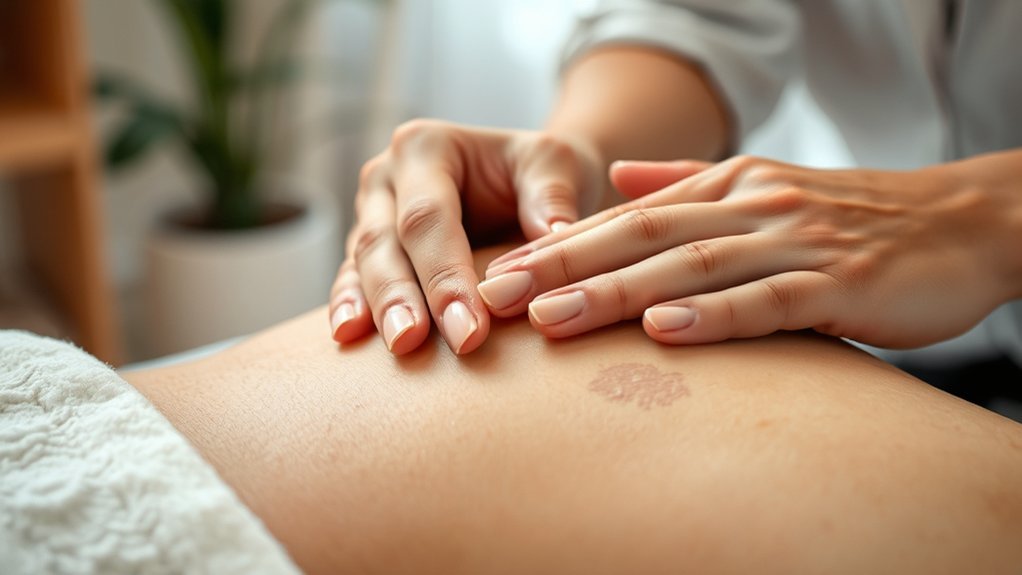Did you know that nearly 100 million Americans experience some form of scarring each year? Understanding the causes and risk factors of scar development is vital for effective treatment, particularly when considering scar massage. Various elements, from the nature of your injury to individual health factors, can influence outcomes. As you explore the benefits and potential risks of scar massage, it’s essential to recognize these complexities before proceeding.
Understanding Scar Formation
When your skin undergoes injury, it responds by forming scar tissue, a natural part of the healing process. This tissue forms as fibroblasts, specialized cells, migrate to the injury site and produce collagen.
Collagen’s role is to strengthen and repair the damaged area. Over time, this tissue matures, often becoming less red or raised. However, the appearance can vary based on factors like the injury’s depth and location.
Scar tissue lacks the same elasticity and functionality as the original skin, which may lead to discomfort or restricted movement. Understanding this formation process is essential for effective scar management and treatment options, enabling you to take proactive steps in your healing journey.
Factors Contributing to Scar Development
Several factors contribute to the development of scars, impacting their appearance and texture. The type and severity of the injury play vital roles; deeper wounds often lead to more pronounced scars.
Your skin type and genetics also influence scar formation, as some individuals are predisposed to keloid or hypertrophic scars. Age and overall health can affect your skin’s healing process; younger skin tends to heal more efficiently.
Additionally, infection during the healing phase can exacerbate scarring. Environmental factors like sun exposure can darken scars, making them more noticeable.
Finally, improper wound care, such as excessive tension on sutures or neglecting hygiene, can hinder ideal healing and contribute to scar formation. Understanding these factors can help you manage and minimize scar development.
Benefits of Scar Massage
Scar massage offers several advantages for improving the appearance and texture of scars. Regularly massaging your scars can enhance blood circulation, which promotes healing and the breakdown of collagen fibers. This may lead to a softer and more flexible scar. Additionally, it can help reduce itching and discomfort associated with scar tissue.
| Benefit | Description |
|---|---|
| Improved Appearance | Reduces scar visibility and texture |
| Enhanced Flexibility | Softens scar tissue, allowing for movement |
| Reduced Discomfort | Alleviates itching and tightness |
Incorporating scar massage into your routine can result in significant improvements over time, making it a worthwhile practice for scar management.
Risks and Considerations of Scar Massage
Although scar massage can provide various benefits, it’s vital to evaluate potential risks and precautions before starting. You should avoid massaging scars that are still healing or have open wounds, as this can lead to infection or further irritation.
Evaluate risks and avoid massaging healing scars to prevent infection and irritation. Always prioritize safety before starting.
If you have certain skin conditions, such as eczema or psoriasis, consult a healthcare provider first. Additionally, be cautious if you have circulation issues or are on blood thinners, as these factors may complicate the process.
Always use clean hands and appropriate techniques to minimize discomfort. Finally, consider your pain tolerance; if you experience significant pain during the massage, it’s important to stop and reassess your approach.
Taking these precautions can help guarantee a safe and effective scar massage experience.
Effective Techniques for Scar Massage
Understanding the right techniques for scar massage can greatly enhance its effectiveness. Start by applying a gentle, moisturizing lotion to the scarred area to reduce friction.
Use your fingertips to apply direct pressure in circular motions, moving outward from the center of the scar. Gradually increase pressure as tolerated, but avoid causing pain. Incorporate vertical and horizontal strokes to promote flexibility and break down collagen fibers.
Aim for 5-10 minutes of massage, two to three times daily. Consistency is key, so make this part of your routine. Monitor the scar for any changes, and consult a healthcare professional if you notice any adverse reactions.
These techniques can improve texture, color, and overall appearance of scars over time.
Frequently Asked Questions
How Long Does It Take for Scars to Fade?
Scars typically take several months to years to fade, depending on factors like their size, depth, and your skin type. You can enhance fading through proper care, including moisturizing and sun protection.
Can Scars Reappear After Massage Therapy?
Yes, scars can reappear after massage therapy, although it’s rare. If there’s excessive pressure or irritation, inflammation may worsen, leading to scar visibility. Always consult a professional to minimize risks and optimize outcomes for your skin.
Are There Any Age Restrictions for Scar Massage?
There aren’t strict age restrictions for scar massage, but it’s best to consult with a healthcare professional. They can help determine if it’s suitable for you based on your specific circumstances and skin condition.
Is Scar Massage Safe During Pregnancy?
Scar massage during pregnancy is generally safe, like nurturing a garden. However, it’s essential you consult your healthcare provider first. They’ll guide you on proper techniques and any precautions needed for your unique situation.
What Products Can Enhance the Effects of Scar Massage?
You can enhance scar massage effects with silicone gel sheets, vitamin E oil, or specialized scar creams. These products hydrate and soften the scar tissue, improving flexibility and overall appearance when used consistently during your massage routine.
Conclusion
Incorporating scar massage can transform a rough, raised scar into a smoother, more pliable texture, enhancing both appearance and comfort. Yet, it’s essential to weigh the potential risks, especially if you have pre-existing conditions or circulatory issues. By consulting with your healthcare provider, you can navigate the delicate balance between the benefits of massage and the risks it may pose. Ultimately, informed decisions empower you to improve your scars while safeguarding your health.
